New Milwaukee Tools from World Of Concrete https://youtu.be/DAsP-QqZuyU?si=vONt4TaVHbq3-_Vb Milwaukee’s MX Fuel system has some new tools added to the 25+ tool platform. I was surprised how light the MX Fuel Backpack Blower is! More new tools from Milwaukee at World Of Concrete included the following: M18™ and M12™ Gangbox Rapid Charger (press release) The M18™ Read more
Featured Articles

New Milwaukee Tools from World Of Concrete
Milwaukee’s MX Fuel system has some new tools added to the 25+ tool platform. I was surprised how light the MX Fuel Backpack Blower is!
More new tools from Milwaukee at World Of Concrete included the following:
M18™ and M12™ Gangbox Rapid Charger (press release)
 The M18™ and M12™ Gangbox Rapid Charger is uniquely designed for users working out of gangboxes and other steel storage spaces on commercial jobsites. By utilizing the strong magnetic base or cleat, the rapid charger can be mounted in multiple different orientations, maximizing storage space within a gangbox. This battery charger includes a 450L flood light which illuminates stored supplies allowing users to spend less time at the gangbox and get back to work quicker. This four bay M18™ and M12™ charger can charge two batteries simultaneously at a rapid rate, then automatically moves to the next two, leading to less downtime. The charger features two M18™ Only bays and two M18™ and M12™ Hybrid Bays, allowing users who operate with both systems to utilize one charger. The M18™ and M12™ Gangbox Rapid Charger includes (2) USB-C 15W ports, providing users the ability to charge small devices such as Milwaukee’s rechargeable personal lighting solutions, phones, and tablets. The rapid charger is optimized for all major models and brands of gangboxes and steel storage found on commercial jobsites. Through its faster charging and intentional design, the M18™ and M12™ Gangbox Rapid Charger is redefining the way our users charge batteries on commercial jobsites.
The M18™ and M12™ Gangbox Rapid Charger is uniquely designed for users working out of gangboxes and other steel storage spaces on commercial jobsites. By utilizing the strong magnetic base or cleat, the rapid charger can be mounted in multiple different orientations, maximizing storage space within a gangbox. This battery charger includes a 450L flood light which illuminates stored supplies allowing users to spend less time at the gangbox and get back to work quicker. This four bay M18™ and M12™ charger can charge two batteries simultaneously at a rapid rate, then automatically moves to the next two, leading to less downtime. The charger features two M18™ Only bays and two M18™ and M12™ Hybrid Bays, allowing users who operate with both systems to utilize one charger. The M18™ and M12™ Gangbox Rapid Charger includes (2) USB-C 15W ports, providing users the ability to charge small devices such as Milwaukee’s rechargeable personal lighting solutions, phones, and tablets. The rapid charger is optimized for all major models and brands of gangboxes and steel storage found on commercial jobsites. Through its faster charging and intentional design, the M18™ and M12™ Gangbox Rapid Charger is redefining the way our users charge batteries on commercial jobsites.
Power Manager – 15 or 20 Amp Circuit
The Milwaukee Power Manager for 15 or 20-amp branch circuits allows users to manage a larger number of M12™, M18™ and MX FUEL™ chargers to charge more batteries. Our Power Manager enables users to maximize the capabilities of their electrical infrastructure and avoid tripped breakers. 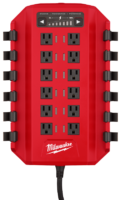 Designed for use with battery chargers, the Power Manager monitors the power being pulled from each outlet and energizes the maximum number of outlets possible. The power manager automatically turns on additional outlets as batteries finish charging and power becomes available. This facilitates users with the highest energy demands to avoid unnecessary infrastructure upgrades, manually changing packs on chargers, and overloading electrical circuits. The Power Manager includes a power throttle to customize the total power being pulled through the device to support other circuit needs. This solution is compatible with the modular PACKOUT™ storage system for easy mounting and flexibility as charging needs change over time. With the Power Manager, users can expand the capabilities of their circuits for extended periods of time, without additional steps to manage the charging process.
Designed for use with battery chargers, the Power Manager monitors the power being pulled from each outlet and energizes the maximum number of outlets possible. The power manager automatically turns on additional outlets as batteries finish charging and power becomes available. This facilitates users with the highest energy demands to avoid unnecessary infrastructure upgrades, manually changing packs on chargers, and overloading electrical circuits. The Power Manager includes a power throttle to customize the total power being pulled through the device to support other circuit needs. This solution is compatible with the modular PACKOUT™ storage system for easy mounting and flexibility as charging needs change over time. With the Power Manager, users can expand the capabilities of their circuits for extended periods of time, without additional steps to manage the charging process.
7-1/4” 24T NITRUS Carbide Framing & Demolition Circular Saw Blade
The 7-1/4” 24T NITRUS™ Carbide Framing & Demolition Circular Saw Blade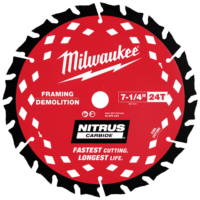 offers the Fastest Cutting and Longest Life in Framing and Demolition Applications. This NITRUS™ Carbide blade delivers unmatched durability – equipped to handle 400+ Nails, 50+ screws, and 120+ ft of shingles. With the sharpest, longest lasting – welded carbide teeth, This NITRUS™ Carbide blade provides a best in class cutting experience from demo to frame and delivers on Milwaukee’s continued promise to produce performance driven circular saw blade solutions for all applications.
offers the Fastest Cutting and Longest Life in Framing and Demolition Applications. This NITRUS™ Carbide blade delivers unmatched durability – equipped to handle 400+ Nails, 50+ screws, and 120+ ft of shingles. With the sharpest, longest lasting – welded carbide teeth, This NITRUS™ Carbide blade provides a best in class cutting experience from demo to frame and delivers on Milwaukee’s continued promise to produce performance driven circular saw blade solutions for all applications.
M18 FUEL™ 7-1/4″ Circular Saw w/ ONE-KEY™
Designed for the professional carpenter and general contractor, M18 FUEL™ 7-1/4” Circular Saw w/ ONE-KEY delivers class-leading performance to complete more demanding applications and achieve greater jobsite productivity. The POWERSTATE™ Brushless Motor generates 6,000 RPM under load, resulting in the most powerful and fastest cutting cordless circular saw on the market. The latest in REDLINK PLUS™ Electronics ensures maximum tool performance and protection from overload, overheating, and over-discharge. When paired with an M18 REDLITHIUM™ FORGE™ HD12.0 Battery this saw 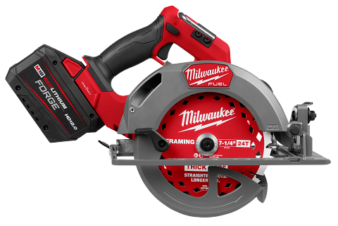 delivers 750 cuts per charge, while maintaining compatibility with all M18 REDLITHIUM™ batteries. This saw also comes with a 7-¼” 24T Thick Kerf Framing Circular Saw Blade, offering the straightest cuts and longer life. The ergonomic, compact, and lightweight design makes the saw a perfect solution for all-day cutting. Equipped with AUTOSTOP™ Advanced Kickback Protection, the saw shuts the power off when a severe kickback event is detected. VACLINK™ Wireless Dust Control allows for direct activation with compatible extractors. ONE-KEY™ is a free inventory app to track and manage all your tools via Bluetooth connectivity. Use it on smartphones, computers, and tablets. Additional user-demanded features include an electric blade brake, LED work light, rafter hook, and all magnesium guards and shoes. Our battery-powered 7-1/4 circular saw is backed by our industry-leading 5-year limited power tool warranty.
delivers 750 cuts per charge, while maintaining compatibility with all M18 REDLITHIUM™ batteries. This saw also comes with a 7-¼” 24T Thick Kerf Framing Circular Saw Blade, offering the straightest cuts and longer life. The ergonomic, compact, and lightweight design makes the saw a perfect solution for all-day cutting. Equipped with AUTOSTOP™ Advanced Kickback Protection, the saw shuts the power off when a severe kickback event is detected. VACLINK™ Wireless Dust Control allows for direct activation with compatible extractors. ONE-KEY™ is a free inventory app to track and manage all your tools via Bluetooth connectivity. Use it on smartphones, computers, and tablets. Additional user-demanded features include an electric blade brake, LED work light, rafter hook, and all magnesium guards and shoes. Our battery-powered 7-1/4 circular saw is backed by our industry-leading 5-year limited power tool warranty.
M18 FUEL™ #10 (1-1/4″) Rebar Cutter
The M18 FUEL™ #10 (1-1/4″) Rebar Cutter is designed for the reinforcing ironworker, providing faster cutting, increased cuts per charge and cold cuts with less sparks than an abrasive wheel. Featuring POWERSTATE™ Brushless Motor Technology, the M18 FUEL Rebar Cutter provides 2 second cuts through #5 bar. When paired with our M18™ REDLITHIUM™ HIGH OUTPUT™ XC6.0 battery, it delivers up to 240 cuts in #5 bar. Easy blade change with a connected cover and limited fasteners. RAPIDSTOP™ Braking provides stop times under 1 seconds with the Milwaukee® #10 (1-1/4”) Rebar Cutting Blade. Exclusively compatible with Milwaukee® #10 (1-1/4”) Rebar Cutting Blade uses carbide teeth to cut faster and with less sparks than an abrasive wheel. The M18 FUEL™ #10 (1-1/4″) Rebar Cutter provides the durability and performance to handle the toughest jobsite conditions and takes steel rod cutting to the next level.
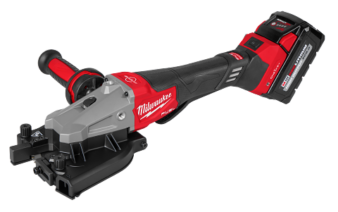

https://vimeo.com/1049487872 On the latest weekly update, we’re at the World of Concrete Show in Las Vegas, we’ll talk new podcasts, and more on AHR, as Tim and John will be hosting a seminar on AI and plumbing. Podcasts https://mechanical-hub.com/podcasts/ AHR Seminar https://www.instagram.com/reel/DFDSOTXRAUe/?utm_source=ig_web_copy_link&igsh=MzRlODBiNWFlZA== Read more
On the latest weekly update, we’re at the World of Concrete Show in Las Vegas, we’ll talk new podcasts, and more on AHR, as Tim and John will be hosting a seminar on AI and plumbing.
Podcasts
AHR Seminar
https://www.instagram.com/reel/DFDSOTXRAUe/?utm_source=ig_web_copy_link&igsh=MzRlODBiNWFlZA==

In the bottom left-hand corner of Colorado, about 50 miles from the Four Corners monument, is the blink-and-you’ll-miss-it town of Dove Creek. The tight-knit community of 667 residents depends heavily on the agricultural industry. Dove Creek, in fact, is known as the Pinto Bean Capitol of the World, thanks to the high-quality beans produced there Read more
In the bottom left-hand corner of Colorado, about 50 miles from the Four Corners monument, is the blink-and-you’ll-miss-it town of Dove Creek. The tight-knit community of 667 residents depends heavily on the agricultural industry. Dove Creek, in fact, is known as the Pinto Bean Capitol of the World, thanks to the high-quality beans produced there.
While the town is small, the support residents show each other is big. For example, the last varsity basketball game created a standing-room-only situation at the old school’s gymnasium.

A Fujitsu AIRSTAGE VU-V heat recovery system was selected for the heating and cooling system at the new Dove Creek Elementary School.
An over-capacity basketball game was the least of the school district’s concerns before construction began on the new Dove Creek in late 2023. The old school struggled to meet the town’s needs in other ways, too.
The 1950s-era building was just too small, and the heating system was uncomfortable and inefficient. Cooling, if it could be called that, was only provided in a few specific areas. Outdated classrooms and insufficient space hindered the implementation of advanced learning programs.
Topping off the challenges, the little district simply didn’t have the funds to improve its facilities.
That changed in 2022 when a BEST grant from the Colorado Department of Education kick-started discussions about building a new school. After 70 years, Dove Creek was getting a new school.

Jonathan John, foreman for Comfort Air Mechanical in Cortez, Colo.
Neenan Archistruction, out of Fort Collins, Colo., was the architect and general contractor for the project. Their work includes a plethora of design-build educational projects. Neenan brought on Comfort Air Mechanical Inc. to design and install the HVAC system for the 30,000-sq.-ft. project, though at the time, a system type hadn’t been selected.
Comfort Air Mechanical was founded in 1988, is based in Cortez, Colo., with 17 people that serve all southwest Colorado.
“Early on, the school board didn’t know exactly what they wanted in an HVAC system,” said Nic McDonald, VP and Partner at Comfort Air. “We discussed the priorities of the project, and it became obvious they wanted simultaneous heating and cooling. Southern Colorado is sunny, and Dove Creek is about 6,800 feet above sea level. There’s a lot of solar gain.”

By Fall semester 2024, the new 30,000 square-foot Dove Creek Elementary School will be home to 110 students and 20 staff.
This led to a conversation about energy efficiency and system longevity. In their words, the board wanted a “cutting edge” system that would bring Dove Creek’s educational system into the 21st century, and a building that would serve as the de facto community center.
“I suggested a heat recovery VRF system,” explained McDonald. “The school board wasn’t aware they could heat and cool the structure with electric heat pumps. As soon as that option was on the table, it was as though none of the others existed. At that point, I hired ME&E Engineering under my contract. At that point, things proceeded quickly.”
A deep bench
At the 2023 AHR Expo, McDonald met with Johnstone Supply’s Jay Castle, Fujitsu General America’s Dale Young and manufacturer’s representatives from GSC Tempered Air Group. Together, along with the engineers at ME&E, they designed a mechanical system based on Fujitsu’s new AIRSTAGE VU-V three-phase VRF equipment.
A great advantage for the project was the strength of the relationships McDonald has at every level of the supply chain. Comfort Air had a previous relationship with the school district, and they had also worked successfully with ME&E Engineering on similar projects in the past.
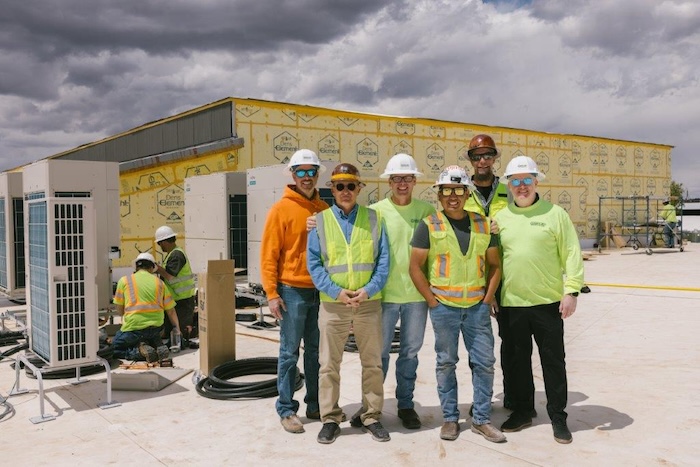
(L-R) Nic McDonald, Jay Castle, Dale Young, Jonathan John, Cory Marks, John McCarthy.
Comfort Air’s relationship with Johnstone Supply and Fujitsu goes back even further.
“I’ve known Jay Caste, at Johnstone, for more than a decade,” said McDonald. “He helps design projects, walks through jobs with our team, and he’s invaluable when it comes to commissioning. We have the same core values, and I value his advice and opinions. The same goes for Dale Young, our regional Fujitsu sales engineer.”
Comfort Air Mechanical has been a Fujitsu Elite dealer for more than six years, and Elite Plus since the program began.
Surprising simplicity
Long before groundbreaking at the new school, McDonald had a 3D model of every mechanical component in the school. That design, which he reviewed regularly with Comfort Air Foreman, Jonathan John, kept the jobsite running ahead of schedule and with no real challenges to speak of.
“The work was surprisingly simple, despite this being one of the larger VRF jobs I’ve personally been involved with,” said John, who spent seven months on the Dove Creek project.
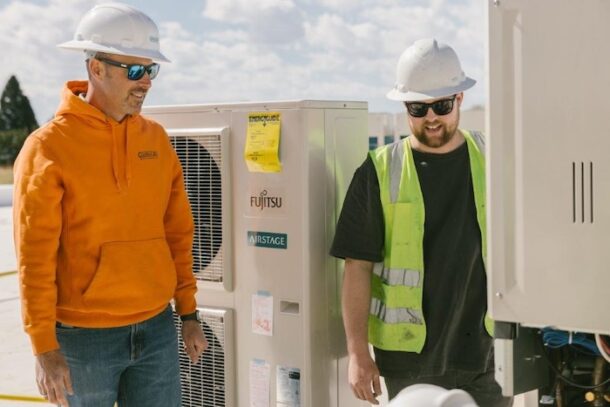
Nic McDonald and Installer Clayton Pool discuss the installation.
“It was also the first VU-V installation we’ve done as a company,” John continued. “The system was spec’d as a heat recovery system, though based on the grant funding for the project, there was a slight possibility that it could have been changed to a heat pump. The fact that the AISTAGE VU-V units can be field-configured for heat pump or heat recovery means that we wouldn’t have had to change the equipment order if the design was changed to heat pump.”
The system included four banks of AIRSTAGE units. Banks one and two each total 24 tons, bank three is 10 tons, and bank four is six tons. These serve a variety of low, medium, and high-static fan coils. Several office spaces are served by ceiling cassettes.
In addition to the AIRSTAGE V-Series equipment, two H-Series systems are also used: a 2.50-ton wall-mount system in the IT room and an identical unit in the electrical room.
Heat recovery
Southern Colorado offers a great opportunity to capitalize on the benefits of heat recovery. The area enjoys roughly 240 sunny days per year, and its relatively high elevation means that solar radiation has much less atmosphere to travel through than at sea level. As a result, buildings in Dove Creek receive high solar gain.
This creates widely varying loads within the building and increases the likelihood of different zones simultaneously calling for heat and cooling. Heat recovery systems essentially “recycle” heat, extracting BTUs from one space that’s calling for cooling and rejecting it into a zone calling for heat. This is especially beneficial in the shoulder seasons.

Summer temperatures in Dove Creek can exceed 90°F, and winter lows are frequently in the single digits, so makeup air was carefully considered during the design phase. In addition to the VRF systems, the rooftop system components include a large CaptiveAir DOAS unit capable of supplying 8,800 CFM of conditioned fresh air. Two RenewAire ERVs are also installed for further efficiency.
“With AISTAGE VU-V units, installing a heat recovery system isn’t much different than installing a heat pump system,” said John. “There are a few piping differences, which are well outlined in the I&O manual, and the addition of branch boxes inside, but that’s about it. Our team moved quickly, and we called Jay Castle any time we had a question.”
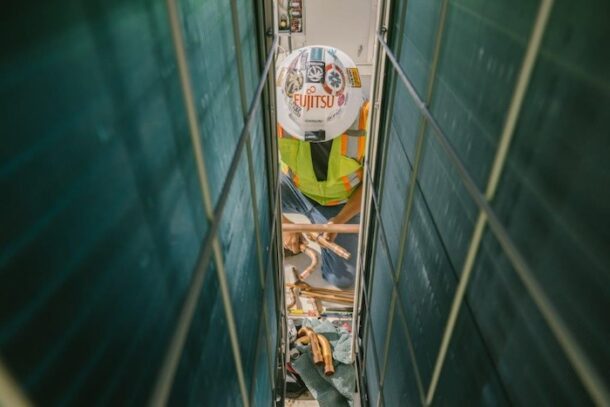
One reason the heat recovery installation went so smoothly was due to the high level of training that Comfort Air Mechanical technicians had gone through before the project.
“Jonathan has been with us for six years,” said McDonald. “This was the largest job I’ve turned him loose on as project lead, and he had an extremely solid crew working under his direction. I was not at all shocked that he handled it as well as he did. If I could just figure out how to clone him, I’d have it made.”
While John’s aptitude and work ethic are exemplary, he claims that training is the reason the job went so well.
“I’ve attended many heat pump training events, including those hosted by Fujitsu in New Jersey, as well as training hosted here in Colorado by Johnstone Supply,” said John. “I’m very familiar with this equipment, even though the VU-V is new to me. That helped immensely.”
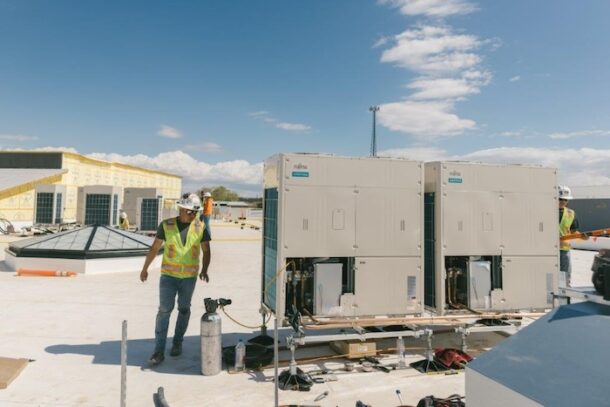
Foreman Johnathan John installs one of several banks of AIRSTAGE VU-V systems at the project.
The VRF equipment was started in late June, with commissioning taking place immediately afterward. Castle joined McDonald and John onsite for a full day. The new building, now home of the Dove Creek Bulldogs, was turned over to the district long before the 2024 Fall semester began.
There have been serious discussions about adding a large solar photovoltaic array to the school’s rooftop, bringing the district’s dream of electrification full circle.
“Whether solar is added or not is yet to be determined,” said McDonald. “If funding is available, solar is likely.”
“With or without solar, the relationships we have in this industry have served this project well,” said McDonald. “Our core values are shared by everyone in our supply chain. Together, we can be proud that we’ve made a massive improvement for this community by providing a school that will serve them well into the future.”

https://vimeo.com/1047355773 Dominating the headlines over the last week or so, the utter devastation from the LA fires has been heartbreaking to watch. The loss of life and homes has been painful to witness from afar, and some fires still burn due to excessively high winds. What turned out to be a fairly innocuous Contractor Spotlight Read more
Dominating the headlines over the last week or so, the utter devastation from the LA fires has been heartbreaking to watch. The loss of life and homes has been painful to witness from afar, and some fires still burn due to excessively high winds. What turned out to be a fairly innocuous Contractor Spotlight, our interview with Yossi Wachtel, owner of Monkey Wrench Plumbing in Los Angeles just got personal.
You can read the Spotlight here:
Contractor Spotlight: Monkey Wrench Plumbing, Heating, Air and Electric—Community First
Podcasts:

What started as a fairly innocuous Contractor Spotlight turned into something much deeper. For Yossi Wachtel, president of Monkey Wrench Plumbing, Heating, Air & Electric, Los Angeles, the impact of the LA fires just hits different. “When the fire started, our typically overbooked dispatch board dropped to 25% capacity, but Los Angeles will rebuild so Read more
 What started as a fairly innocuous Contractor Spotlight turned into something much deeper. For Yossi Wachtel, president of Monkey Wrench Plumbing, Heating, Air & Electric, Los Angeles, the impact of the LA fires just hits different. “When the fire started, our typically overbooked dispatch board dropped to 25% capacity, but Los Angeles will rebuild so that’s not what keeps me up at night. What really shakes me is hearing a customer say, ‘Why fix the plumbing when we might not have a house to come back to?’ That’s not just a cancelled appointment, that’s a neighbor facing the unthinkable,” says Wachtel.
What started as a fairly innocuous Contractor Spotlight turned into something much deeper. For Yossi Wachtel, president of Monkey Wrench Plumbing, Heating, Air & Electric, Los Angeles, the impact of the LA fires just hits different. “When the fire started, our typically overbooked dispatch board dropped to 25% capacity, but Los Angeles will rebuild so that’s not what keeps me up at night. What really shakes me is hearing a customer say, ‘Why fix the plumbing when we might not have a house to come back to?’ That’s not just a cancelled appointment, that’s a neighbor facing the unthinkable,” says Wachtel.
Monkey Wrench’s service area—Pacific Palisades, Santa Monica, West Hollywood, West LA, Altadena—has been affected. “These aren’t just dots on our dispatch map, they are homes where we’ve fixed leaks, installed water heaters, and built relationships over years. Now many of those same homes are in harm’s way. These aren’t just statistics on a news report. These are people we live with, shop at the same supermarkets with, go to the gym with, and work with.”
But what really matters to Wachtel is that Monkey Wrench is a community business, and right now the community needs something different than plumbing services. They need support, resources, and reassurance. “So, while our phones might be quieter today, our commitment to this community has never been louder. We’re here for whatever our neighbors need—whether that’s emergency plumbing assistance or just someone who knows the area and can point them toward help. This isn’t about business anymore. It’s about being there for our community when they need us most. To all our customers, employees, and fellow Angelenos: Stay safe. Material things can be replaced, lives cannot,” says Wachtel.
The Spotlight
Yossi Wachtel’s path to plumbing was anything but traditional. After studying in rabbinical college in Australia, Wachtel found himself drawn to the trades through construction work. What started as painting closets evolved into a fascination with the mechanics of plumbing. In 2007, Wachtel moved to California and founded Monkey Wrench with just one truck. Today, we operate nearly 50 trucks and employ around 100 team members, serving residential customers throughout Los Angeles.
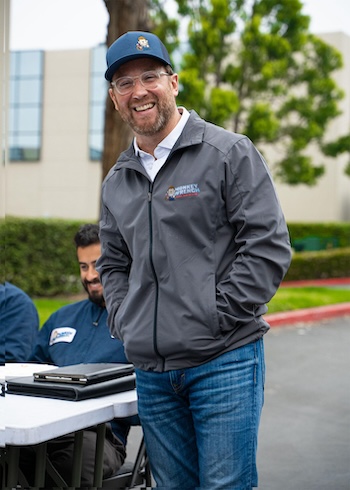 “I discovered plumbing in my late twenties while working in property management. What captivated me wasn’t just the technical aspects; it was the opportunity to be someone’s hero. Every call was a chance to solve problems and make a real difference in people’s lives. After three years learning the trade, I took the leap to start my own company,” recalls Wachtel.
“I discovered plumbing in my late twenties while working in property management. What captivated me wasn’t just the technical aspects; it was the opportunity to be someone’s hero. Every call was a chance to solve problems and make a real difference in people’s lives. After three years learning the trade, I took the leap to start my own company,” recalls Wachtel.
Wachtel has always had that eye for business. “I’ve always been entrepreneurial—I started my first business at age seven,” says Wachtel. “But with plumbing, I saw a clear need for professionals who could deliver exceptional customer service.”
And, because Wachtel is an ordained rabbi, he uses what he’s learned in his plumbing business. “While I chose plumbing over rabbinical work, I still apply those teachings about ethics and service to others in how we run our business.
The Narrative, Reworked
According to Wachtel, and many others enjoying a career in the trades, college isn’t the only path to success. He says that the trades offer an incredible opportunity to build a rewarding career without student debt. “At Monkey Wrench, we have technicians earning six-figure incomes, and more importantly, they’re making a real difference in people’s lives. Plus, you’ll never have to worry about your job being outsourced or replaced by Artificial Intelligence,” says Wachtel.
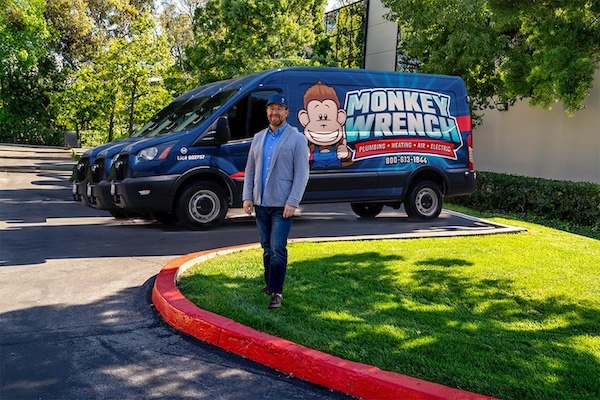
According to Wachtel, the industry should partner more with high schools, create clear career advancement paths, showcase modern technology and tools, highlight success stories and emphasize the entrepreneurial opportunities. “We need to change the narrative about trade careers. It’s not just about unclogging toilets—it’s about problem-solving, using advanced technology, and helping people.”
Mentor and Relation Ships
Wachtel says that his greatest mentors have come through Nexstar Network. “They taught me that being a great plumber isn’t enough; you need to be a great business person too,” says Wachtel.
Not only did Wachtel find mentorship through Nexstar, he says that joining Nexstar was a game-changer for us. “I made a significant investment in that first-year membership when I could barely make payroll—it was terrifying but turned out to be the best decision I’ve ever made. Continuous education isn’t just important; it’s essential. The industry evolves constantly, and if you’re not learning, you’re falling behind.”
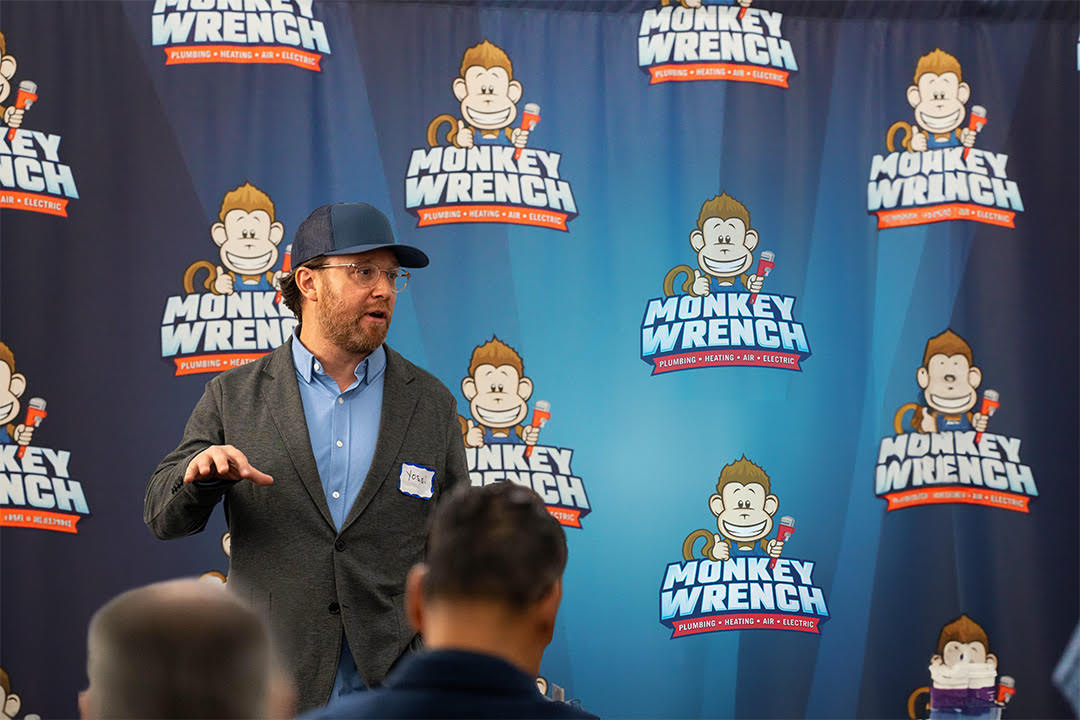
Today, he’s passionate about mentoring others, especially through the company’s developing trade academy, which would help young people discover and develop their potential in the trades. Wachtel says it’s becoming the next big mission at Monkey Wrench. “Nothing brings me more joy than seeing our team members buy their first homes or achieve personal milestones through their careers with us.”
The biggest challenge is finding the right people who share the vision for exceptional service. But for Wachtel, the rewards far outweigh the challenges. “Recently, one of our employees became the first person in three generations of his family to buy a home. Those moments—seeing our team members grow and succeed—that’s what makes this all worthwhile,” says Wachtel.

In fact, one of Monkey Wrench’s team members celebrated their 10-year anniversary with the company. “These milestones remind me why we do what we do. It’s about creating opportunities and changing lives through this amazing trade,” says Wachtel.
While Wachtel is proud of the community he’s created at Monkey Wrench, the company is in good hands. Both of Wachtel’s sons work for the business—one is the Operations Manager, and the other works in the marketing department. “It’s incredible watching them grow into their roles and bring fresh perspectives to the company. While I hope they’ll continue the legacy, I want it to be their choice. They need to earn it and want it,” says Wachtel.
Wachtel’s Top Tips for Starting a Business
• Perfect your craft before going solo
• Join a best practices organization (it changed everything for us)
• Focus on building systems, not just fixing pipes
• Invest in your people’s growth
• Stay true to your business model—avoid the temptation of “shiny objects”
